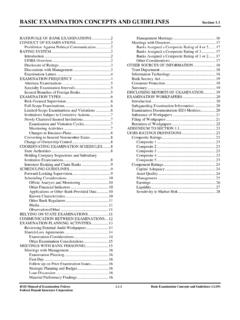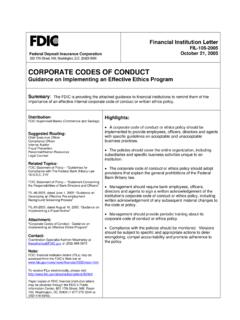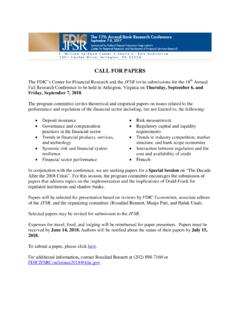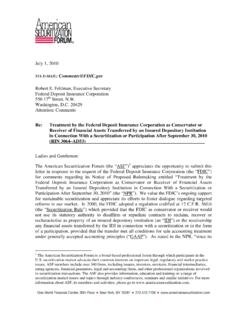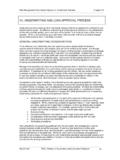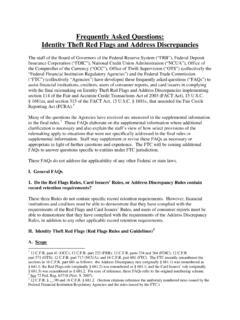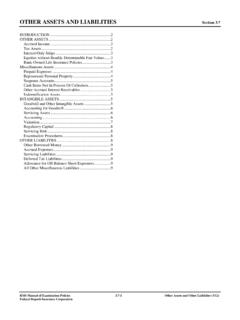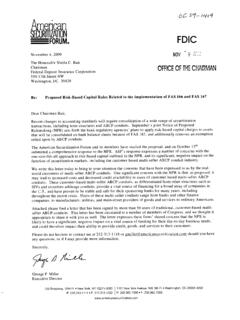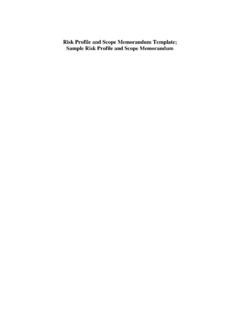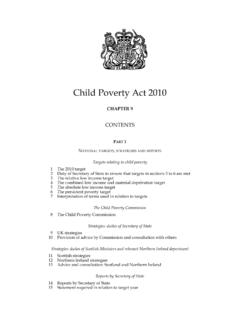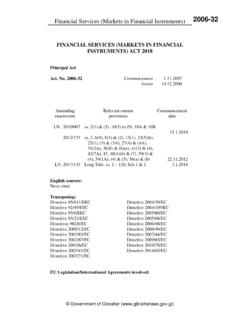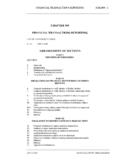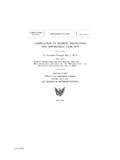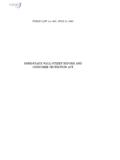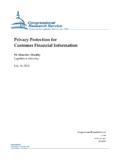Transcription of FDIC Overdraft Payment Supervisory Guidance …
1 fdic Overdraft Payment Supervisory Guidance Background As highlighted by the fdic s November 2008 Study of Bank Overdraft Programs, institutions continue to expand the types of Overdraft Payment programs provided to consumers. With changes in technology, the range of services and number of transactions potentially causing an Overdraft has broadened to include not only paper checks, but also automated teller machine (ATM) withdrawals, point-of-sale (POS) debit card use, preauthorized debits, telephonic fund transfers, and online banking transactions. Program participation has sometimes been based on automatic enrollment, and customers may not have fully understood the risks and potential costs involved.
2 Overdraft fees can exceed the amount of the Overdraft and can occur multiple times in a single banking day, depending on the type and amount of transactions and the transaction-clearing practices of the institution. For example, batch processing checks and clearing them from largest to smallest likely increases the number of items triggering an Overdraft . Extremely high costs in comparison to the Overdraft benefit and/or permitting product over-use often result in customer dissatisfaction and complaints. Serious financial harm can result for customers with a low or fixed income.
3 Overview of Comments Received On August 11, 2010, the fdic issued its proposed Overdraft Payment Supervisory Guidance (FIL-47-2010) for public comment. The agency received more than 900 written comments from a range of financial institutions and industry trade groups, individual consumers, consumer advocacy and public interest groups, and one member of Congress. Most financial institution and industry commenters expressed concern about regulatory burden, especially in light of recent implementation of new Federal Reserve Board (FRB) Overdraft -related A number of institutions raised specific questions about implementation of the Guidance .
4 Industry commenters raised concerns regarding the appropriateness or degree of: (a) involvement expected by boards of directors in program oversight; (b) triggers for excessive use of overdrafts; (c) costs and utility of contact with customers with a significant number of overdrafts to discuss alternatives; (d) daily limits on fees and restrictions on transaction posting order; and (e) instituting an opt-out policy for non-electronic transactions. Also, some industry commenters had concerns that the Guidance might create an unlevel playing field with other depository institutions.
5 Most individual consumer commenters supported the Guidance . Many consumers gave specific examples of situations where they were subject to repeated and often disproportionate automated Overdraft program fees. Consumers raised concerns about bank practices to maximize Overdraft fees, confusion over disclosures of account balances, and transaction processing order. 1 The FRB issued Overdraft related requirements under Regulation DD (Truth in Savings Act) and Regulation E (Electronic Fund Transfer Act). Consumer advocacy and public interest groups generally supported the Guidance , but encouraged the fdic to take additional measures to address excessive use and fees, such as: (a) requiring absolute fee limits; (b) mandating that a consumer always receive the lowest-cost option available; (c) requiring an opt-in requirement for all types of Overdraft transactions; (d) restricting aggressive marketing of opting-in to Overdraft coverage for ATM and one-time point-of-sale (POS) transactions, as now required by Regulation E.
6 And (e) a prohibition on manipulating transaction processing. After reviewing public comments, the fdic continues to believe that there are significant reputational and safety and soundness risks associated with many Overdraft Payment programs. The final Guidance incorporates suggestions from commenters to refine and clarify expectations. The final Guidance is intended to assist fdic -supervised institutions in identifying, managing and mitigating risks associated with Overdraft Payment programs, including risks that could result in serious financial harm to certain consumers relative to one of the core products offered by many insured depository institutions.
7 Supervisory Expectations The fdic expects institutions to implement effective compliance and risk management systems, policies, and procedures to ensure that institutions manage any Overdraft Payment programs in accordance with the attached 2005 Joint Guidance on Overdraft Protection Programs2 (Joint Guidance ) (FIL-11-2005) and the FRB November 12, 2009 amendments to Regulation E, to avoid harming consumers or creating other compliance, operational, financial , reputational or other risks. As changes are made to Overdraft Payment programs in response to regulatory developments or to implement additional recommendations, institutions are reminded to ensure that customer communications ( , agreements, correspondence, marketing materials, etc.)
8 Are updated accordingly, present information accurately and are not misleading. The fdic is particularly concerned about the risks posed by automated Overdraft Payment programs, which are established programs, often partially or fully computerized, that are used by institutions to determine whether non-sufficient fund (NSF) transactions qualify for Overdraft coverage based on pre-determined criteria. Ad hoc Overdraft payments typically involve irregular and infrequent occasions on which a bank employee exercises discretion in a specific instance about whether to pay an item or not, as a customer accommodation and not on a pre-determined or formulaic basis.
9 Such ad hoc activities are not the focus of this Guidance . Similarly, linked lines of credit are not the focus of this Guidance . Management should also ensure that all Overdraft Payment and line of credit practices conform to all applicable laws and regulations. To mitigate safety and soundness and compliance risks, and avoid violations of related laws and regulations, the fdic expects its supervised institutions to take the following actions regarding automated Overdraft Payment programs: Ensure that boards of directors provide appropriate oversight of programs, consistent with their ultimate responsibility for overall compliance, and that on an ongoing and regular basis management provides oversight of program features and operation.
10 Appropriate steps include an annual review of an Overdraft program s key features. 2 70 Fed. Reg. 9127 (Feb. 24, 2005). Review their marketing, disclosure, and implementation of such programs to minimize potential consumer confusion and promote responsible use. Train staff to explain program features and other choices. Prominently distinguish account balances from any available Overdraft coverage amounts. Note also that, as of January 1, 2010, Regulation DD (Truth in Savings Act) prohibits institutions from including Overdraft coverage amounts in any account balance information provided by an automated Monitor programs for excessive or chronic customer use, and if a customer overdraws his or her account on more than six occasions where a fee is charged in a rolling twelve-month period, undertake meaningful and effective follow-up action, including, for example.
